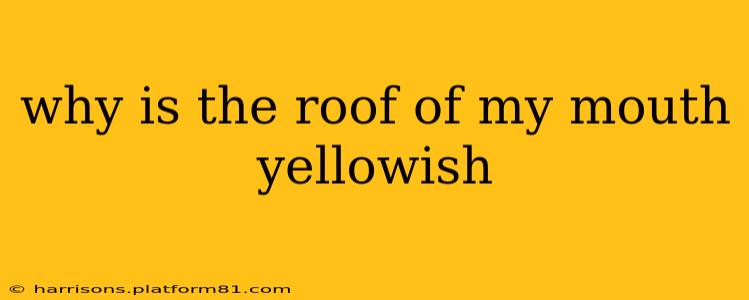A yellowish roof of your mouth, or palate, can be concerning. While sometimes harmless, it's crucial to understand the potential causes to determine if medical attention is needed. This comprehensive guide explores various reasons why your palate might appear yellow, helping you identify the source and seek appropriate treatment if necessary.
What Could Cause a Yellowish Roof of the Mouth?
Several factors can contribute to a yellow palate. Let's explore some of the most common:
1. Dehydration:
A simple yet often overlooked cause is dehydration. When you're dehydrated, your saliva production decreases, leading to a drier mouth. This dryness can concentrate pigments and bacteria, potentially resulting in a yellowish tint on the palate. Staying well-hydrated by drinking plenty of water throughout the day can often resolve this issue.
2. Smoking and Tobacco Use:
Smoking and chewing tobacco are significant contributors to oral discoloration. The nicotine and other chemicals in tobacco products stain the soft tissues of the mouth, including the palate. Quitting smoking and avoiding tobacco products is crucial for improving oral health and reversing discoloration.
3. Food and Drinks:
Certain foods and beverages, like curry, turmeric, and some brightly colored candies, can temporarily stain the palate. This staining is usually superficial and easily removed with brushing and rinsing.
4. Medications:
Some medications can have side effects that include oral discoloration. Certain antibiotics, for instance, can cause a yellowish or brownish tint to the mouth tissues. This is usually temporary and resolves once the medication is discontinued. Always consult your doctor or pharmacist if you suspect medication is causing oral discoloration.
5. Jaundice:
Jaundice is a condition characterized by yellowing of the skin and whites of the eyes, often extending to the mouth. It's typically caused by a buildup of bilirubin in the blood, often indicating liver or gallbladder problems. If you notice yellowing of your skin and eyes in addition to your palate, seek immediate medical attention.
6. Oral Thrush (Candidiasis):
Oral thrush, a fungal infection caused by an overgrowth of Candida albicans, can sometimes manifest as yellow patches on the palate. These patches can be accompanied by other symptoms such as pain, burning, and a thick, white coating on the tongue. Treatment usually involves antifungal medications.
7. Leukoplakia:
Leukoplakia refers to white or yellowish patches that develop on the gums, tongue, or inner cheek. While not always cancerous, leukoplakia can sometimes be a precursor to oral cancer. Regular dental checkups are essential to monitor any changes.
8. Poor Oral Hygiene:
Neglecting proper oral hygiene can lead to a buildup of plaque and bacteria, resulting in discoloration and potentially bad breath. Regular brushing, flossing, and using mouthwash can significantly improve oral hygiene and reduce the risk of discoloration.
When Should I See a Doctor?
While some causes of a yellowish palate are benign and easily resolved, others require professional medical attention. Consult a doctor or dentist immediately if:
- The yellowing is accompanied by other symptoms like jaundice (yellowing of skin and eyes), pain, or bleeding.
- The discoloration persists despite good oral hygiene practices.
- You have a history of smoking or tobacco use.
- You suspect a medication side effect.
Regular dental checkups are crucial for maintaining good oral health and detecting potential problems early. Your dentist can provide a proper diagnosis and recommend appropriate treatment based on your individual circumstances. Don't hesitate to seek professional advice if you're concerned about the yellowing of your palate.
